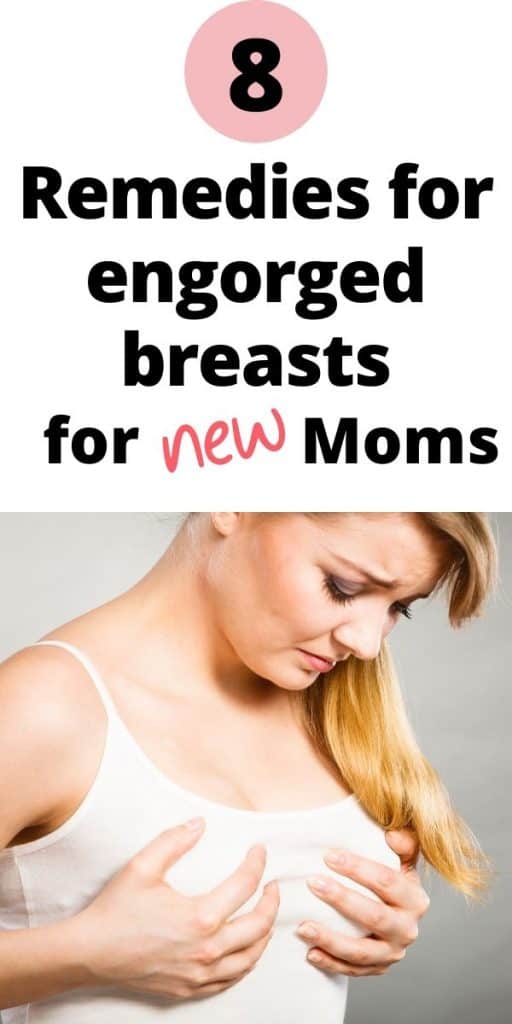As a new breastfeeding mom, people often worry their baby isn’t getting enough milk. But in that first week after baby comes, you may have the opposite problem: What if you have a breast milk oversupply? How do you handle painful, engorged breasts?
PS: If you’re a new or expecting mom looking for the best breastfeeding course on the internet, read my review of Milkology in this article!
Engorgement and oversupply is likely to strike sometime during the first week postpartum. As long as you know to handle it, you’ll have a few inconvenient days, but it will get better.
If you don’t take care, though, engorgement can lead to blocked ducts or even mastitis! So yes, even though you’ve got a new baby to worry about, it’s still critical that you take care of yourself.

RELATED: 7 Self-care tips for the postpartum stage
Disclosure: This article contains affiliate links. As an Amazon associate I earn from qualifying purchases. You can read my full policy here.
Read on to learn what causes engorgement, how to treat it, and how to make sure milk oversupply doesn’t cause tummy trouble for your new baby.
Table of Contents
What causes engorgement the first week or two postpartum?
The very first few days after your baby is born, you produce something called colostrum. This “liquid gold” is thicker than mature breastmilk and is nutritionally adapted for newborns.
RELATED: Advantages of breastfeeding

RELATED: Newborn breastfeeding: 12 tips
A few days later though (probably between days 2 and 5 postpartum), your breasts begin to grow (again?!), possibly a full cup size! This is because the release of your placenta signals your body to start producing mature milk. Your body is getting ready to feed that new baby!

Initially, your body may get a little overexcited and make too much milk. When that happens, your breasts can become painfully swollen, or engorged. If your baby goes several hours without eating, your boobs can feel as hard as rocks, and they can really hurt! Your breasts may be really warm as well, another sign of the inflammation going on.
Plus, you’ll likely leak breastmilk between feedings and even during feedings (from the other side). If this is you, breast pads are a must during this stage of life. I like having reusable breast pads because it’s cheaper and better for the environment.
I recommend this brand of pads because you get seven pairs in one set. Unless you’re doing laundry every other day, one or two pairs of nursing pads won’t cut it!
But as your baby takes as much milk as he needs, it signals to your body how much breastmilk to continue making. Within a week or two, your body should adjust. But knowing how to cope in between times can feel like a lifesaver!
Symptoms of breastmilk oversupply for babies
Unfortunately, oversupply can affect your baby as well as you. Learn the symptoms of oversupply for your little one!
RELATED: What to expect with a new baby – 8 tips
How to know if baby’s tummy is upset from breast engorgement
If nothing is done about oversupply for a few days, your baby can be bothered with an upset tummy.

You may have heard of foremilk and hindmilk. Your milk is made largely of water and fat, and it can separate, even in the breast. If the milk has separated, the first milk a baby gets (foremilk) tends to be thin, like skim milk, while hindmilk, which your baby can get at the end of a feeding, is fattier. (This is why you shouldn’t switch breasts with each feeding, by the way. Just keep with one unless your baby is clearly hungry and wants to switch).
If you’re engorged for a while and keep accidentally only giving your baby foremilk, his tummy will eventually get upset. You can tell because he’ll likely be extra fussy (although in honesty, when you’re a new parent, it’s sometimes hard to judge “extra fussy” compared to “normal fussy”), and his poop will be greenish and possibly frothy.
If this keeps up, you might want to try block feeding (which I discuss in detail below). Block feeding helps make sure your baby gets both foremilk and hindmilk, soothing his tummy. In addition, it should help your oversupply within a day or two.
What to do when you’re so engorged that baby can’t latch
If your breasts are especially full and hard, it can be hard for baby to latch. In this case, it can be helpful to do breast compressions. Basically, place your fingers flat on your areola so that your nipple is between two fingers. Gently press backwards (you’ll likely leak some milk) so that your nipple is a bit more prominent, and then try to get baby to latch.
Relief for sore breasts
Of course, if you’re dealing with engorgement, you’re going to have pain of your own. It hurts when your breasts are super full of milk!

Fortunately, there’s easy remedies for engorgement that will have you feeling better in no time.
Keep nursing!
The number one rule for relieving engorgement: empty that breast!
You will feel some immediate relief once the breast is less full. And over the course of a few days, your body will learn exactly how much milk your baby needs and will back down your supply.
With that said, what you don’t need to do when you’re engorged is to start pumping several ounces of milk on top of the feedings your baby needs. That tells your breasts that they need to make enough milk for two (your baby and the pump), so your supply won’t go down to normal! Save pumping for at least few more weeks.
If your breasts are really sore and your little bub just isn’t hungry, it can be a good idea to drain some milk using hand compressions. Only express enough to relieve the engorgement some, not enough to completely empty the breast. This video is not the most exciting ever, but it is a great tutorial on how to hand express milk (the woman in the video is producing colostrum, but the mechanics are the same for mature milk).
Use breast massage to keep milk moving
If milk pools inside a duct in your breast, it can cause a clogged duct or even an infection. These problems are really painful. But massaging breasts, particularly while nursing, can help drain milk that’s stuck in one area.
Basically, use your hand to gently massage the more painful area. You can also use gentle hand compression to help move milk out.
Block feeding or block nursing
Block feeding is a great way to slow down milk production when you’re dealing with engorgement. For 3-4 hours, only use one breast over and over. That way, your baby is sure to get both foremilk and hindmilk. In addition, this feeding method can help slow down milk production to the right amount.

When you’re block feeding, if the unused breast gets so sore that it really hurts, you might want to do a little hand expression on that breast, just enough to relieve the pressure. Don’t try to empty that breast! It’ll get its turn on the next “block.”
Warm shower
Finally, a warm shower, combined with massage and hand compressions, can help relieve painful breasts. You have to be careful with this one though, because the shower can also stimulate more milk production. Just use the massage and compression in the shower long enough to provide relief, but not to empty the breasts completely.
Relief for raw nipples
Often for new moms, you not only have engorgement, but you may have raw nipples too!
If your nipples are cracked, bleeding, or usually coming out in a “lipstick shape” after your baby nurses, I suggest talking to a lactation consultant, as there’s likely something going wrong with nursing.
But if you just have just have mild irritation of your nipples, a couple products could be a life saver for you during those first few weeks.
Gel soothies

These things feel great. If you put them in the fridge before using them, they’ll be even more of a relief for sore nipples.
Lanolin
Lanolin is the best moisturizer for raw nipples. You can’t just use regular lotion or Vaseline on your nipples when breastfeeding, because it wouldn’t be good for your baby to ingest during her next feeding! Lanolin, a natural product, is safe for baby and helps soothe chapped nipples. I recommend this three-pack of small tubes that you can leave in your favorite nursing spots around the house.
What happens if you get mastitis?
Sometimes, you can still get mastitis even if you do follow all these breastfeeding tips. If that’s the case, you need to get to the doctor. You’ll likely be prescribed an antibiotic.

But the important thing to remember is that you SHOULD still breastfeed when you have mastitis! Your baby can’t get sick from your mastitis, but continuing to drain milk from the area will help your infection clear up faster.
In addition, you need to drink plenty of fluids and rest. You’re sick, so treat your body as such!
I realize this is a lot of information, and it’s only for one tiny topic of breastfeeding!. If you’re looking for the be-all, end-all resource for breastfeeding, for every stage from newborn to toddlerhood and beyond, this is your book.
The Womanly Art of Breastfeeding is evidence-based and covers every issue you will ever encounter with breastfeeding, from pumping issues to medication questions and more. I can’t recommend it enough.
Remember these engorgement tips for growth spurts later
Your baby’s first week is unlikely to be your only brush with engorgement. Your baby will have several growth spurts throughout his first year of life, and each time, he’ll want to nurse extra.
During the growth spurt, you may be worried. Why is he eating all the time? Is my supply okay? On top of that, your breasts may feel emptier than usual.
RELATED: How to know your breastfed baby is eating enough
But don’t worry, this is normal. You’ll know the growth spurt is past when your little one starts eating less. But then, your breasts are likely to become engorged again! After all, they had been pumping out all this extra milk for your baby, and now he’s not taking it.
But don’t worry, you can use all these tips for relieving engorgement, and you’ll both be back to normal within a day or two.
Last thoughts on breast engorgement and breastfeeding
And I get it: When you’re first breastfeeding, your baby is only a few days old, and your everything hurts from birth, it’s understandable that any issues with breastfeeding can feel insurmountable. But the thing to remember is that engorgement only lasts a few days (maybe a week at most). It will get better!
And when it gets better, your breasts will be less hard and sore. But don’t let that scare you!
Just because your breasts aren’t full or painful later doesn’t mean you don’t have enough milk. If you’re worried, though, check out this article (or this one). It’ll let you know that you are still producing enough milk even though your breasts feel better!


This was really helpful! I had no idea just how engorged breasts would feel. Glad to get some relief!